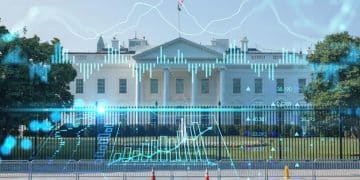Decoding Fed Minutes: Key Insights into Monetary Policy Shifts

Decoding the Latest Federal Reserve Minutes: Insider Insights into Monetary Policy Shifts reveals nuanced details about the Fed’s considerations regarding inflation, employment, and future monetary policy adjustments, offering vital clues for investors and the public.
Delving into the Federal Reserve’s minutes provides a crucial window into the central bank’s decision-making processes and potential policy directions. Decoding the Latest Federal Reserve Minutes: Insider Insights into Monetary Policy Shifts can help investors and economists anticipate market movements and understand the rationale behind the Fed’s actions.
Understanding the Significance of Federal Reserve Minutes
The Federal Reserve, the central bank of the United States, plays a vital role in shaping the country’s economic landscape. One of the key ways the Fed communicates its policy intentions and internal debates is through the release of the minutes from its Federal Open Market Committee (FOMC) meetings. These minutes provide a detailed account of the discussions and considerations that influence monetary policy decisions.
Analyzing these minutes is essential for anyone seeking to understand the direction of the U.S. economy, from investors and economists to policymakers and the general public. They offer insights into the Fed’s thinking on issues such as inflation, employment, and economic growth, as well as potential future policy adjustments.

Key Areas of Focus in the Latest Fed Minutes
The Federal Reserve’s minutes typically cover a range of important topics that are critical to understanding the state of the economy and the direction of monetary policy. These areas of focus often change depending on the prevailing economic conditions, but some themes remain consistently relevant.
Let’s explore some of the key themes and areas that typically receive close attention in these periodic publications.
Inflationary Pressures and Outlook
Inflation is always a primary concern for the Federal Reserve. The minutes provide insight into how the FOMC views current inflationary pressures, whether they are seen as transitory or persistent, and what factors are contributing to them.
Employment and Labor Market Conditions
The Fed aims to achieve maximum employment, so the minutes always contain an assessment of the labor market. Discussions often include unemployment rates, job growth, wage trends, and labor force participation rates. These indicators provide valuable clues about economic health and potential risks.
- Analysis of recent job reports and employment trends.
- Discussion of wage growth and its impact on inflation.
- Assessment of labor force participation rates.
- Consideration of potential risks to the labor market outlook.
In conclusion, understanding the key areas of focus within the Fed Minutes helps provide a well-rounded picture of not only the current economic status, but, also, of the projected path that the country is preparing to take.
Decoding the Language: What to Look For
The language used in the Federal Reserve minutes can often seem technical and nuanced. However, understanding certain key phrases and concepts can help decipher the underlying meaning and implications of the Fed’s statements. It is important to go beyond simply reading the words on the page to also understand the subtext and potential impact.
By understanding key concepts, the reader can translate the document into an actionable plan for future investments and economic decisions.
“Data Dependent”
This phrase indicates that the Fed’s future policy decisions will be guided by incoming economic data. The FOMC will closely monitor indicators such as inflation, GDP growth, and employment figures to determine the appropriate course of action.
“Transitory” vs. “Persistent”
When discussing inflation, the Fed often uses these terms to describe the nature of price increases. If inflation is deemed “transitory,” it is expected to be temporary and self-correcting. If it is considered “persistent,” the Fed may be more inclined to take action to curb it.

“Balance Sheet Normalization”
This refers to the process of reducing the size of the Federal Reserve’s balance sheet, which expanded significantly during the period of quantitative easing. Normalization typically involves ceasing to reinvest the proceeds from maturing securities and, potentially, selling off some assets.
Understanding the jargon and language of the Fed Minutes will help any reader understand the economic path the country is on. Recognizing the possible impacts and implications of the statements made by the Fed is instrumental in preparing for the implications of potential economic movement.
Impact on Financial Markets and Investment Strategies
The release of the Federal Reserve minutes often has a noticeable impact on financial markets, including stock prices, bond yields, and currency values. Investors closely scrutinize the minutes for clues about the Fed’s future policy intentions, which can inform investment strategies.
Understanding how the markets are likely to react is key to investment decisions. Often, experienced investors study the minutes and make predictions for the market to best prepare themselves.
Stock Market Reactions
If the minutes suggest a more hawkish stance (i.e., a greater likelihood of interest rate hikes), stock prices may decline, particularly for companies that are sensitive to interest rates. Conversely, a dovish stance (i.e., a greater likelihood of rate cuts or continued easing) could boost stock prices.
Bond Market Reactions
Bond yields typically move in response to changes in interest rate expectations. If the minutes signal a more hawkish outlook, bond yields may rise, as investors anticipate higher interest rates. A dovish stance could cause bond yields to fall.
- Anticipating market reactions to different statements.
- Diversifying portfolios to mitigate risks.
- Adjusting investment strategies based on the Fed’s outlook.
The FOMC’s messaging greatly impacts the markets, especially based on wording and the tone of the statements published. Smart investors watch for these statements and adjust their tactics accordingly to reduce risk.
Interpreting Disagreements and Dissents
The FOMC is composed of several members, including the seven governors of the Federal Reserve System and five Reserve Bank presidents. While the committee strives for consensus, disagreements and dissenting opinions can sometimes arise. These disagreements can provide valuable insights into the range of views within the Fed and the potential for future policy shifts.
Studying these statements helps paint a complete picture of not only the agreement, but, also, any disagreement or controversy that arises during the decision making process.
Identifying Dissenting Voices
The minutes clearly indicate when a member dissents from the majority view, along with the reasons for their dissent. These dissenting views can highlight alternative perspectives on the economy and potential risks that are not fully addressed by current policy.
Understanding the Implications of Disagreements
Even if a dissenting view does not prevail in the current meeting, it can still influence future policy decisions. If the concerns raised by a dissenting member prove to be valid, the FOMC may need to adjust its approach in subsequent meetings.
Understanding the range of views and potential policy shifts will allow you to better prepare for economic changes. Taking the time to thoroughly read the minutes of the FOMC meetings will reduce the risk of surprises in the economic playing field.
Looking Ahead: Future Monetary Policy Signals
By carefully analyzing the Federal Reserve minutes, investors and economists can gain a better understanding of the Fed’s outlook and potential future policy actions. This can help them make more informed decisions and anticipate market movements. While no one is able to clearly see the future, properly understanding the Fed’s Minutes can go a long way to providing foresight.
This foresight can be used to create a path to economic stability as it is based on a solid understanding of where the playing field will be in the future.
Monitoring Key Indicators
Keep a close eye on the economic indicators that are most relevant to the Fed’s policy decisions, such as inflation, employment, and GDP growth. Changes in these indicators can signal a potential shift in the Fed’s stance.
Staying Informed About Fed Communications
In addition to the minutes, the Fed releases a variety of other communications, including speeches by Fed officials and press conferences. Staying informed about these communications can provide valuable context and insights into the Fed’s thinking.
- Planning for different economic scenarios.
- Seeking professional financial advice.
- Staying agile and adaptable in your investment strategies.
Carefully reading the minutes of the FOMC meetings of the Federal Reserve can go a long way to properly forecasting where the economy is trending. Understanding these critical publications allows you to better prepare yourself for possible economic shifts in the future. Staying informed is a key to smart investing.
| Key Point | Brief Description |
|---|---|
| 💡 Inflation Outlook | How the Fed views current inflationary pressures (transitory or persistent). |
| 💼 Labor Market | Assessment of unemployment rates, job growth, and wage trends. |
| 🏦 Balance Sheet | Insights into reducing the Fed’s balance sheet (“Normalization”). |
| 🗣️ Dissent | Highlights differing viewpoints within the FOMC. |
Frequently Asked Questions
▼
The Federal Reserve minutes are detailed records of the Federal Open Market Committee (FOMC) meetings, providing insights into the discussions and decisions regarding U.S. monetary policy.
▼
They offer transparency into the Fed’s decision-making process, helping investors, economists, and the public understand the factors influencing monetary policy.
▼
The minutes are typically released three weeks after each FOMC meeting, which occurs about eight times per year.
▼
Key topics include discussions on inflation, employment, economic growth, interest rate adjustments, and the Federal Reserve’s balance sheet.
▼
The minutes are available on the Federal Reserve Board’s official website under the “Monetary Policy” section.
Conclusion
Decoding the Federal Reserve minutes offers indispensable insights into monetary policy shifts, equipping investors and economists with a deeper understanding of economic trends and the Fed’s strategic responses. By carefully monitoring these minutes, stakeholders can better anticipate market movements and refine their investment strategies, contributing to more informed and effective financial decision-making.





